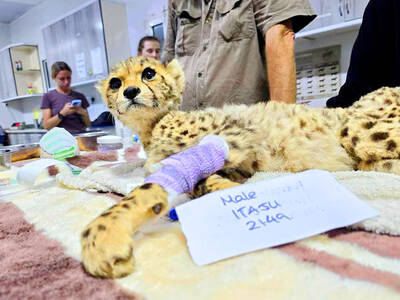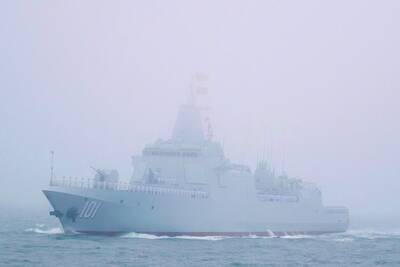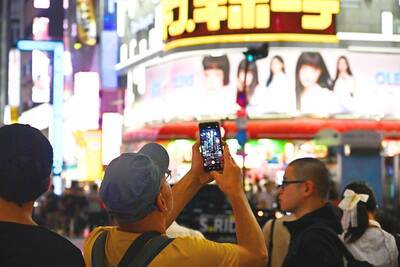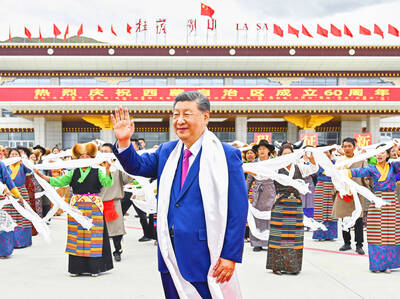On the sidewalks and the subways it is clear: Japan is becoming a sea of surgical masks. It is about pollen, about germs and even a little about China, its polluting rival across the sea.
Yano Research Institute says it is a ¥26 billion (US$274 million) market. The industry leader, Kowa Co, says it plans to quintuple production this year.
“It seems about half the people outside are wearing masks now,” said businessman Masahiko Haneda, whose boss has warned him to wear a mask at work whenever he catches a cold.
However, the biggest reason for the face coverings is hay fever. Japan’s pollen levels are five times higher than they were last spring, thanks to a hot summer last year and a sudden spike in temperatures this month that has caused Japanese cedar and hinoki cypress trees — the main culprits — to release their pollen all at once.
“The pollen is really bad this year,” said Takeshi Nunomura, who said he coughs constantly at night.
Germs are another reason. When Japanese catch a cold, they often wear masks to keep from coughing or sneezing on others in tightly packed trains and in the office. And some perfectly healthy people wear masks to keep from inhaling those germs.
This year, there is the added alarm about tiny particles of pollution called PM2.5, which are less than 2.5 micrometers in size, or about 1/30th the width of a human hair, and can penetrate deep into the lungs.
While the Japanese Environment Ministry says the level of PM2.5 particles is about the same as last year, the media has played up the dangers and said that much of the pollution is coming from China. That has helped drive consumer demand for the masks.
“They say a lot of these masks can’t block those tiny particles, but it makes me feel better to wear it,” said Saori Takeuchi, a mask-clad Tokyo woman walking with her nine-year-old son, also wearing a mask.
Drug stores prominently display dozens of types of masks, with many claiming to “keep out 99 percent” of pollen, germs and dust.
Sendai-based mask maker Iris Ohyama Inc says sales are twice as good as last year.
Mask makers have come up with several variations. There are masks designed to fit snugly around the nose so they do not fog up glasses, and masks that can be taped directly to the cheeks.
Some pollen-control devices are not masks at all. There are small plugs with nets in them that the user pops in their nostrils. There is a cream and a spray, and one company sells a small bag of chemicals that is worn like a necklace and is supposed to form a bubble of pollen control around the user.
Masks are popular in Japan because they are a cheap, easy way to keep pollen from entering the nose and causing an allergic reaction, says Shigeharu Fujieda, an allergy specialist at Fukui University.
While Fujieda said he was not particularly worried about the Chinese pollution, he did say it could exacerbate hay fever by continuing to irritate the nose even after pollen levels decline.
The portion of Japanese who suffer from hay fever has grown to a third from a tenth 30 years ago. The reasons are not exactly clear. The increase in pollen from Japanese cedar trees — many planted after World War II to increase greenery — is one factor, while diet may be another, experts say.
Global warming seems to be playing a role in pollen production, said Norio Sahashi, director of the Association of Pollen Information in Narashino, Chiba Prefecture. Generally hotter summers in recent years are causing the trees to produce more pollen cones, he said.

Ten cheetah cubs held in captivity since birth and destined for international wildlife trade markets have been rescued in Somaliland, a breakaway region of Somalia. They were all in stable condition despite all of them having been undernourished and limping due to being tied in captivity for months, said Laurie Marker, founder of the Cheetah Conservation Fund, which is caring for the cubs. One eight-month-old cub was unable to walk after been tied up for six months, while a five-month-old was “very malnourished [a bag of bones], with sores all over her body and full of botfly maggots which are under the

BRUSHED OFF: An ambassador to Australia previously said that Beijing does not see a reason to apologize for its naval exercises and military maneuvers in international areas China set off alarm bells in New Zealand when it dispatched powerful warships on unprecedented missions in the South Pacific without explanation, military documents showed. Beijing has spent years expanding its reach in the southern Pacific Ocean, courting island nations with new hospitals, freshly paved roads and generous offers of climate aid. However, these diplomatic efforts have increasingly been accompanied by more overt displays of military power. Three Chinese warships sailed the Tasman Sea between Australia and New Zealand in February, the first time such a task group had been sighted in those waters. “We have never seen vessels with this capability

A Japanese city would urge all smartphone users to limit screen time to two hours a day outside work or school under a proposed ordinance that includes no penalties. The limit — which would be recommended for all residents in Toyoake City — would not be binding and there would be no penalties incurred for higher usage, the draft ordinance showed. The proposal aims “to prevent excessive use of devices causing physical and mental health issues... including sleep problems,” Mayor Masafumi Koki said yesterday. The draft urges elementary-school students to avoid smartphones after 9pm, and junior-high students and older are advised not

Chinese President Xi Jinping (習近平) attended a grand ceremony in Lhasa yesterday during a rare visit to Tibet, where he urged “ethnic unity and religious harmony” in a region where China is accused of human rights abuses. The vast high-altitude area on the country’s western edge, established as an autonomous region in 1965 — six years after the 14th Dalai Lama fled into exile — was once a hotbed for protest against Chinese Communist Party rule. Rights groups accuse Beijing’s leaders of suppressing Tibetan culture and imposing massive surveillance, although authorities claim their policies have fostered stability and rapid economic development in